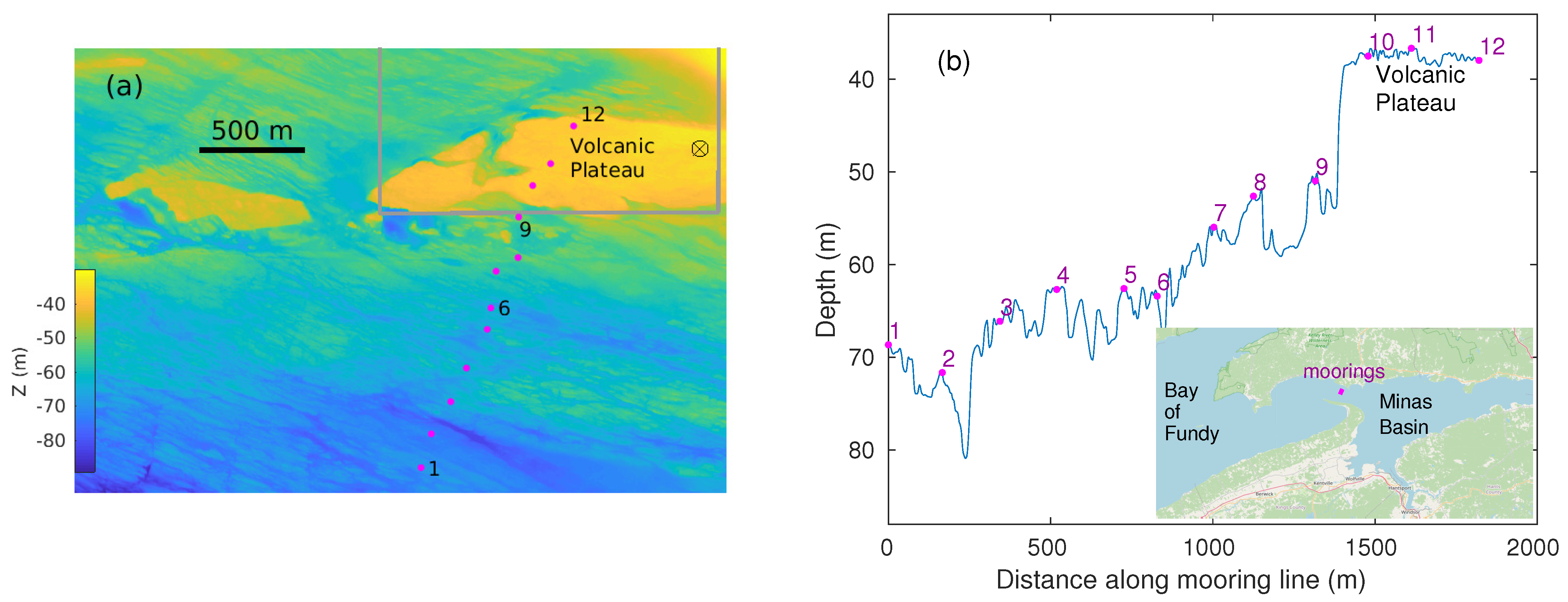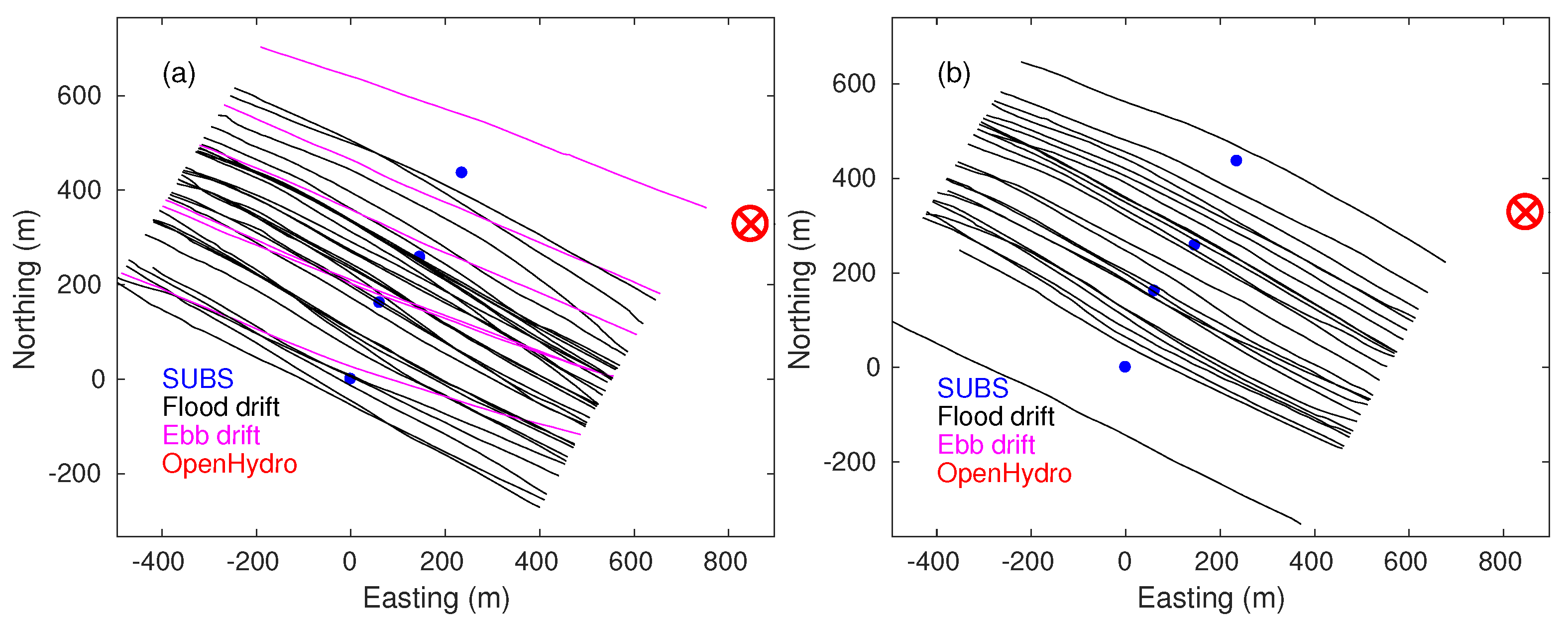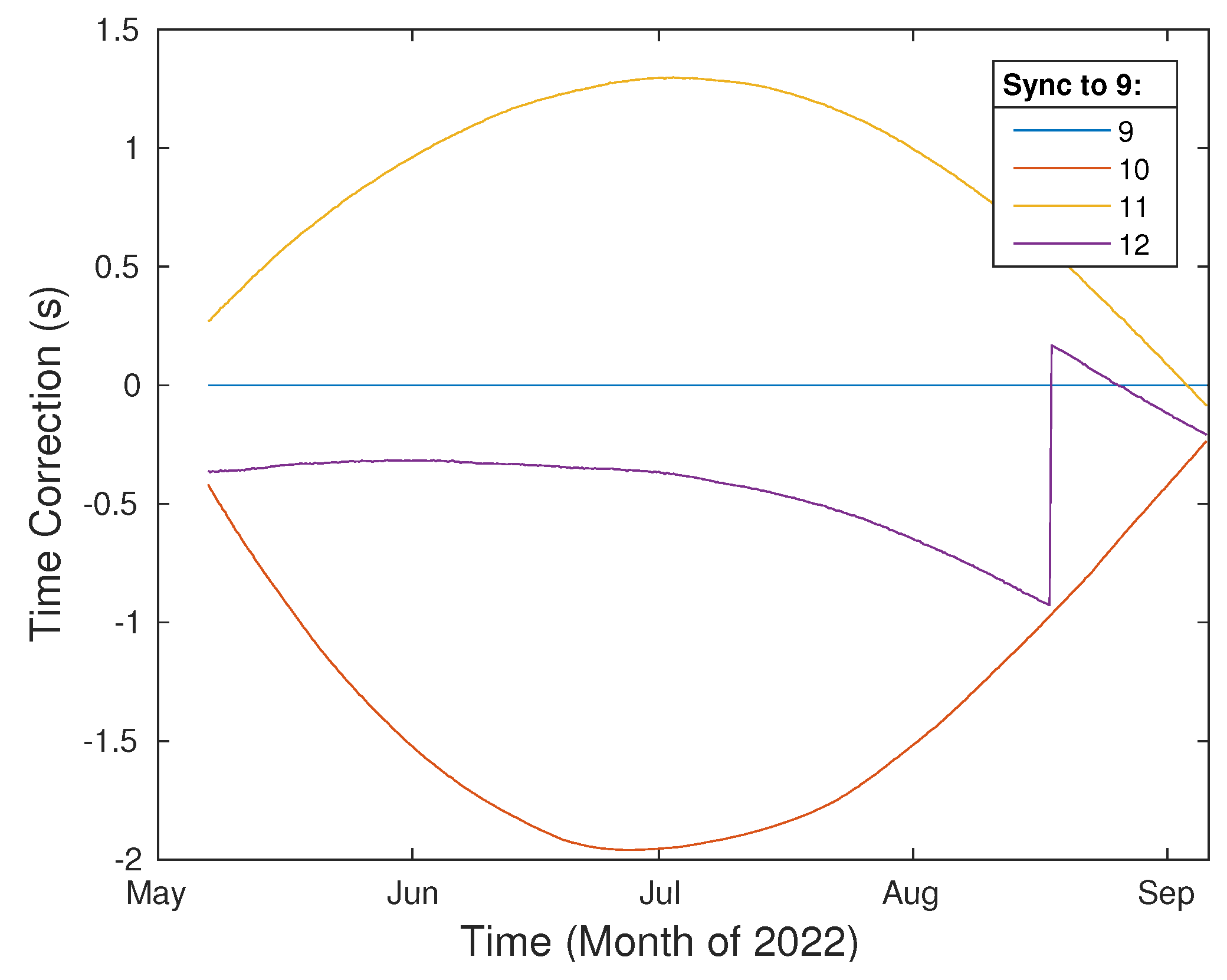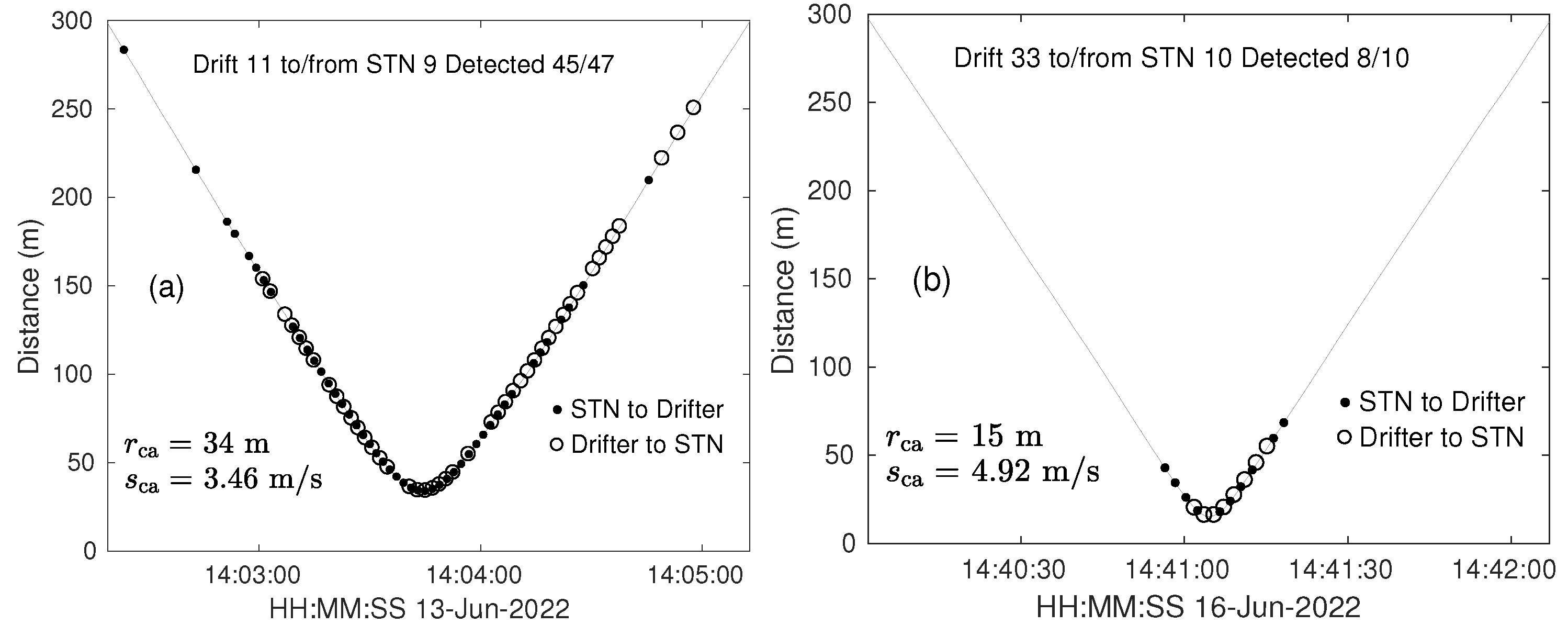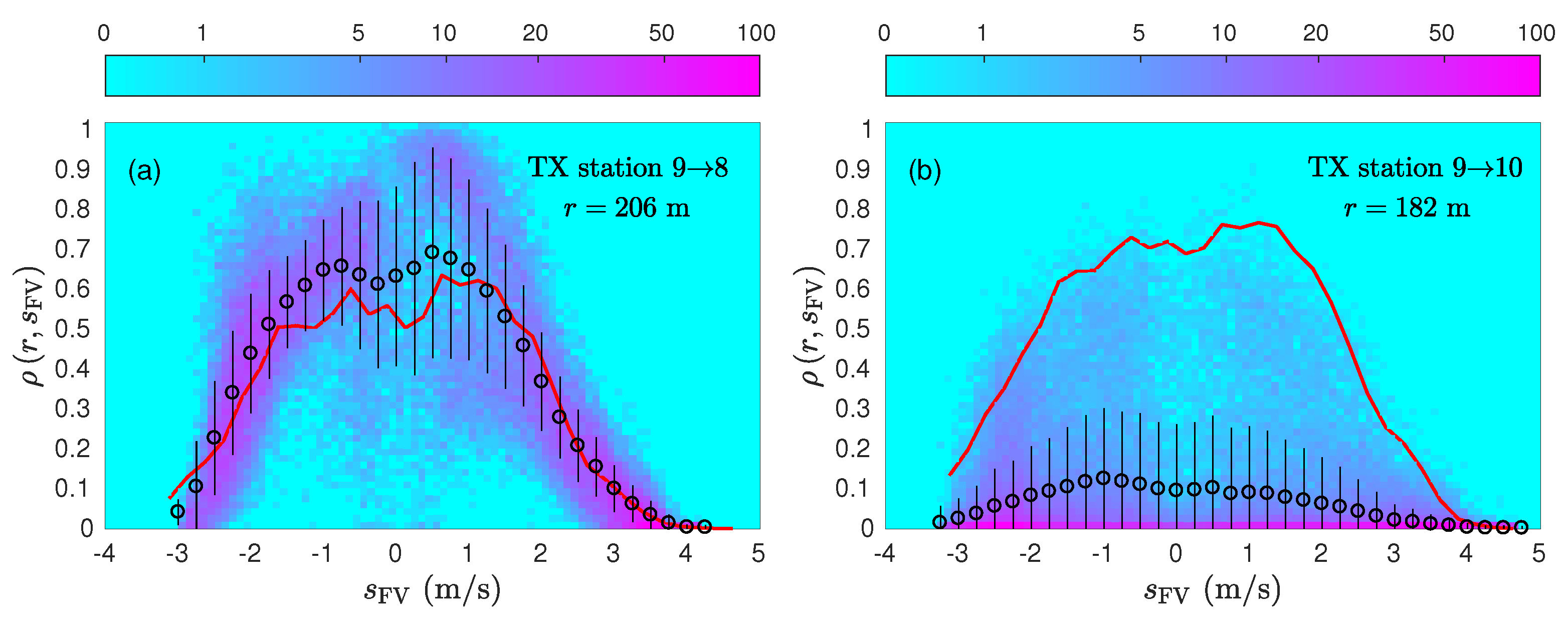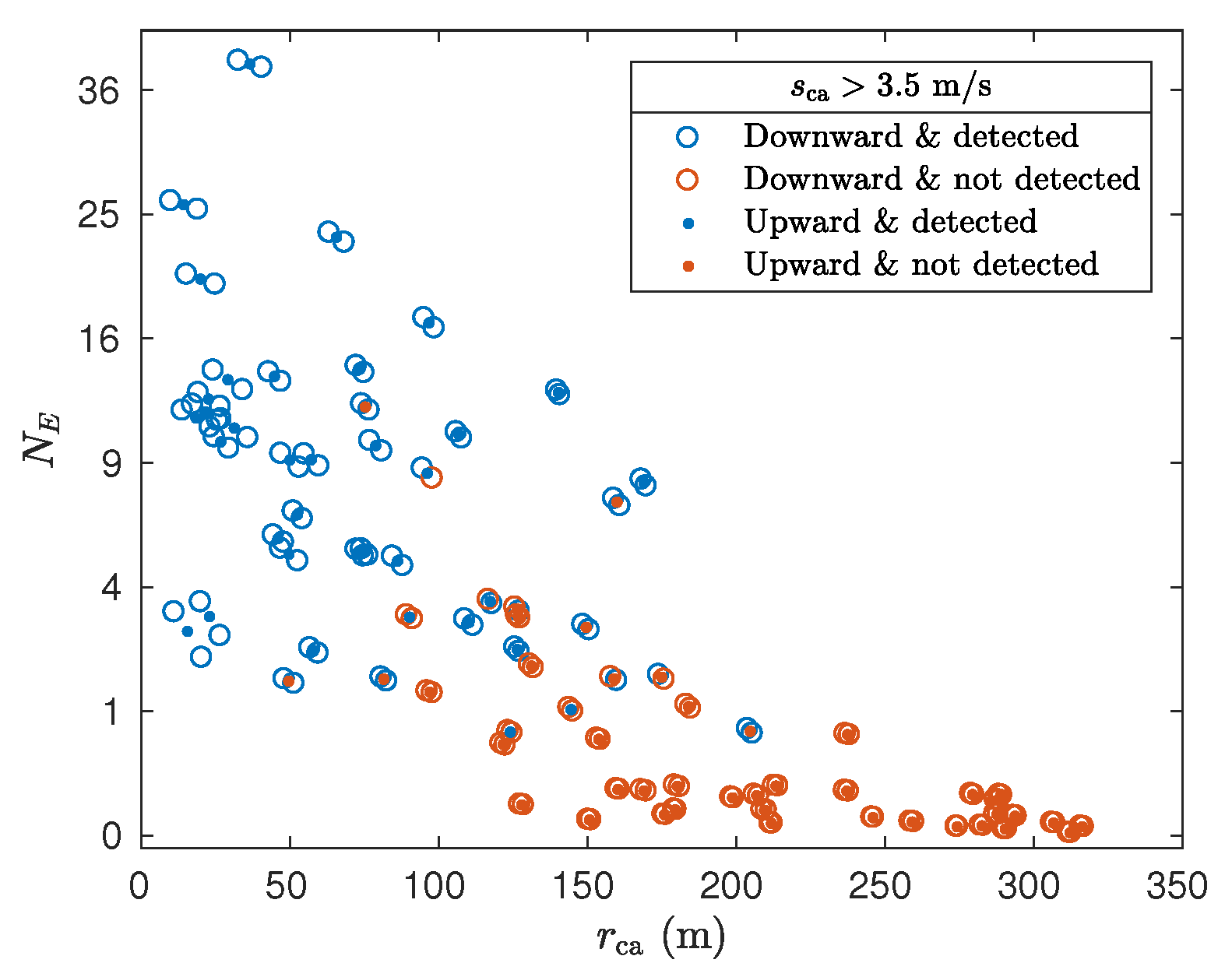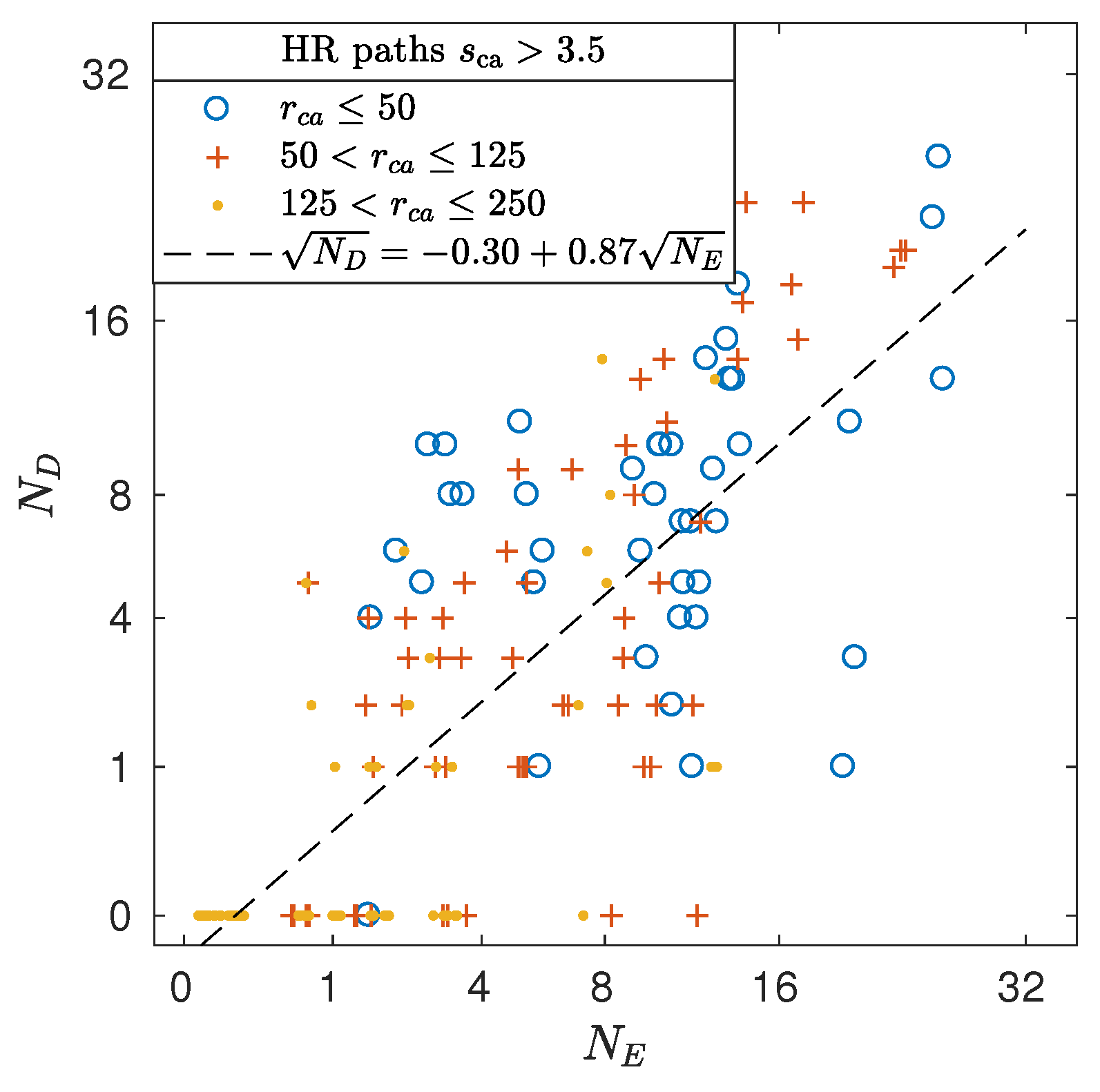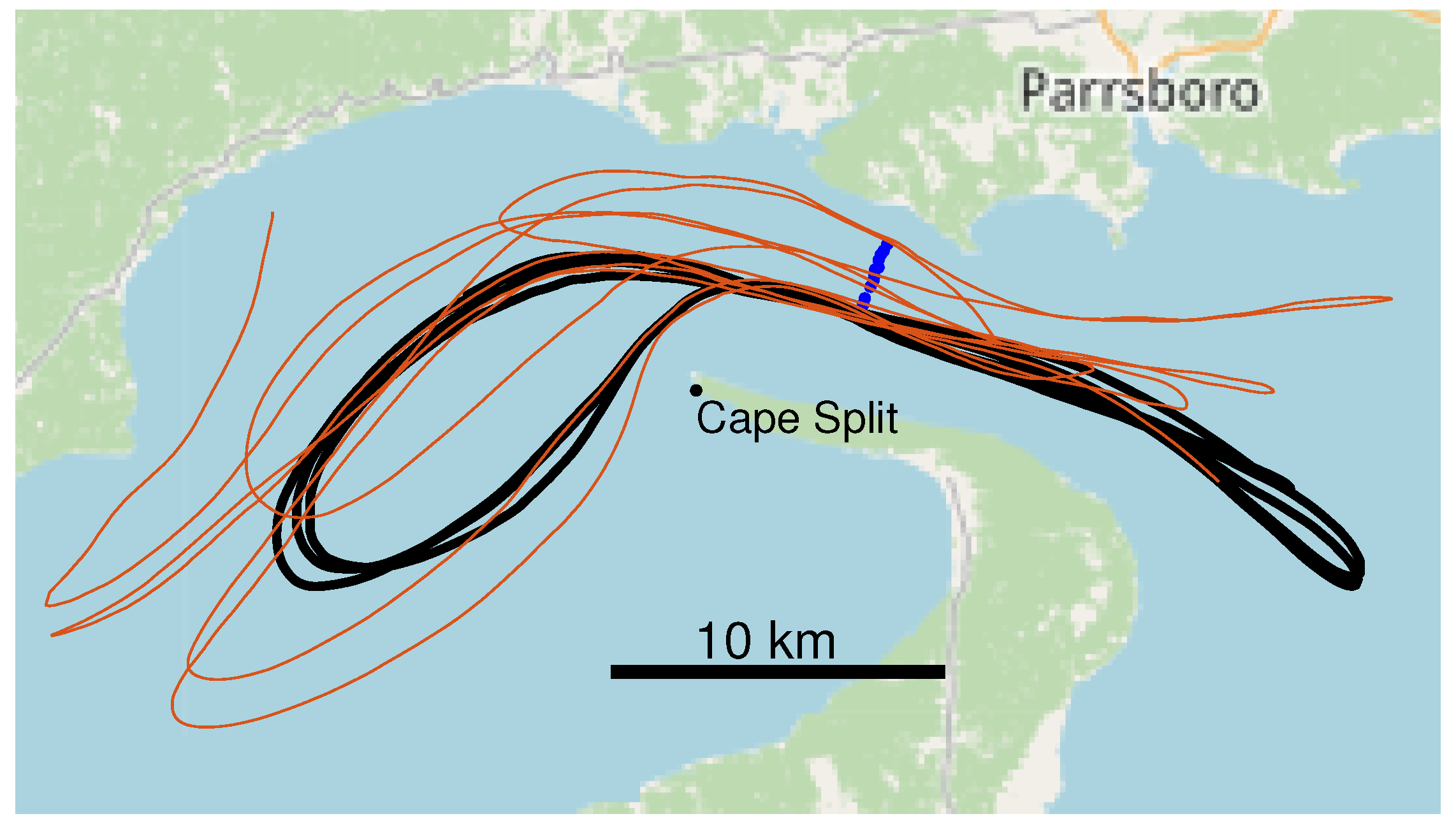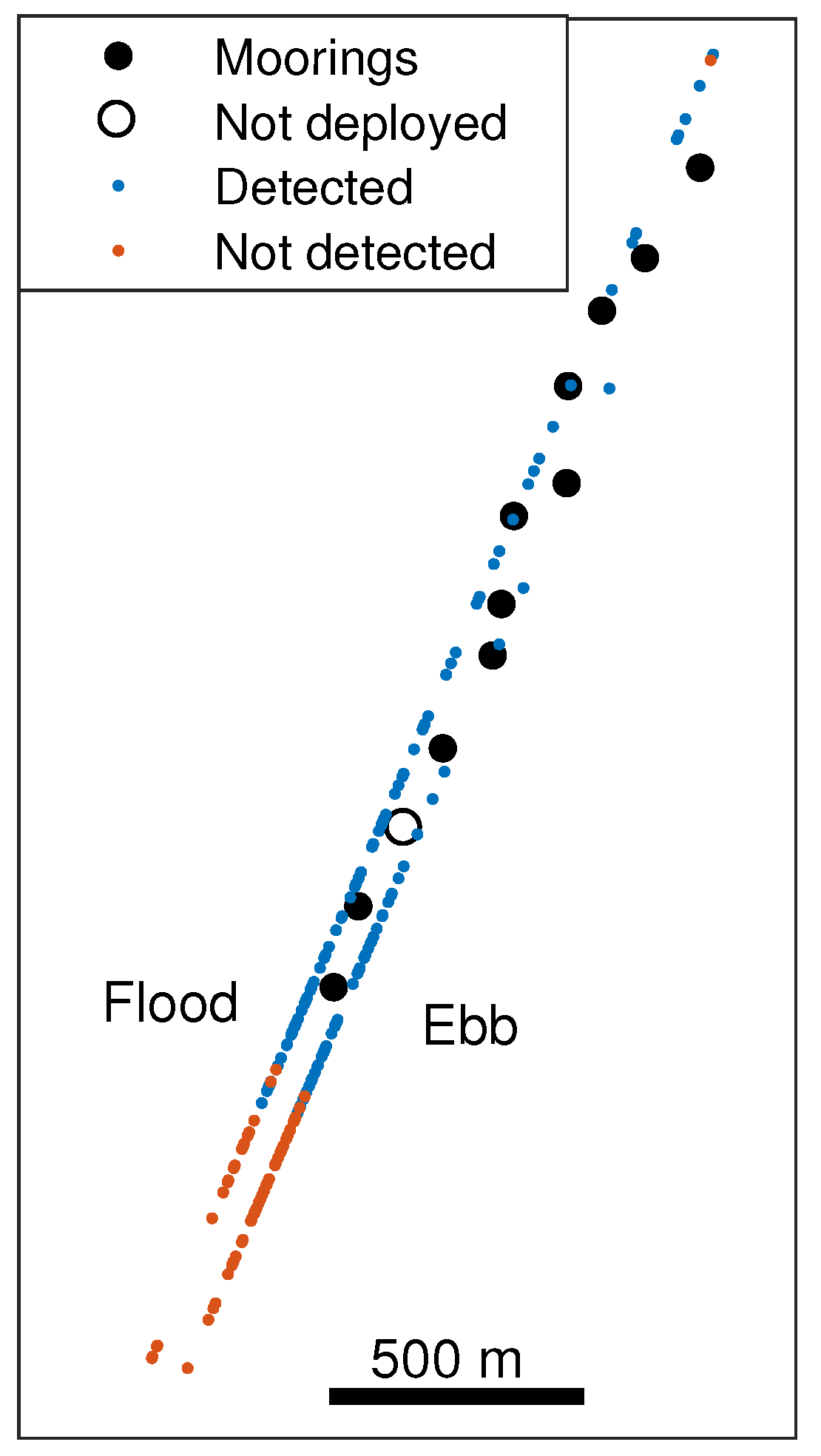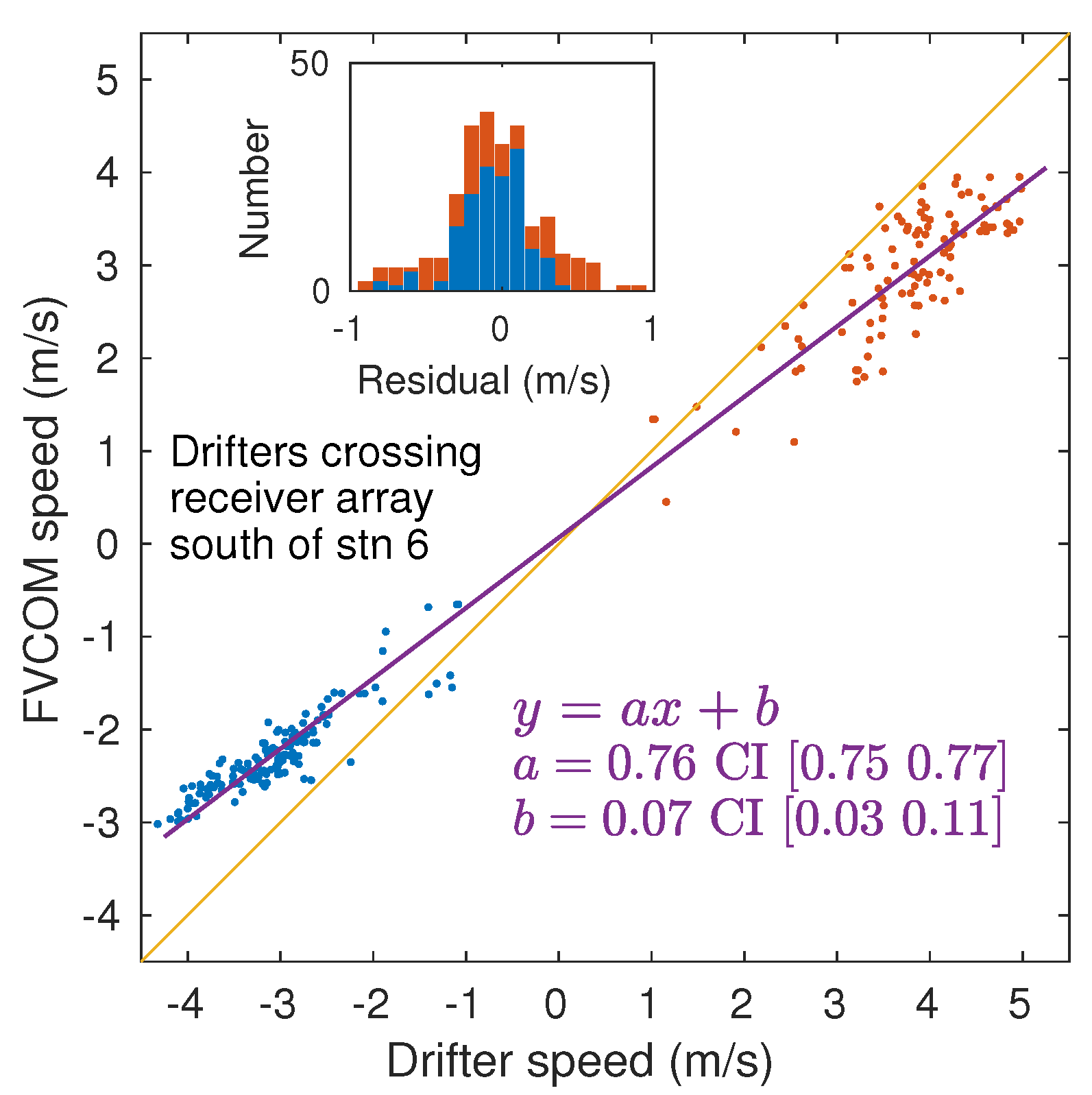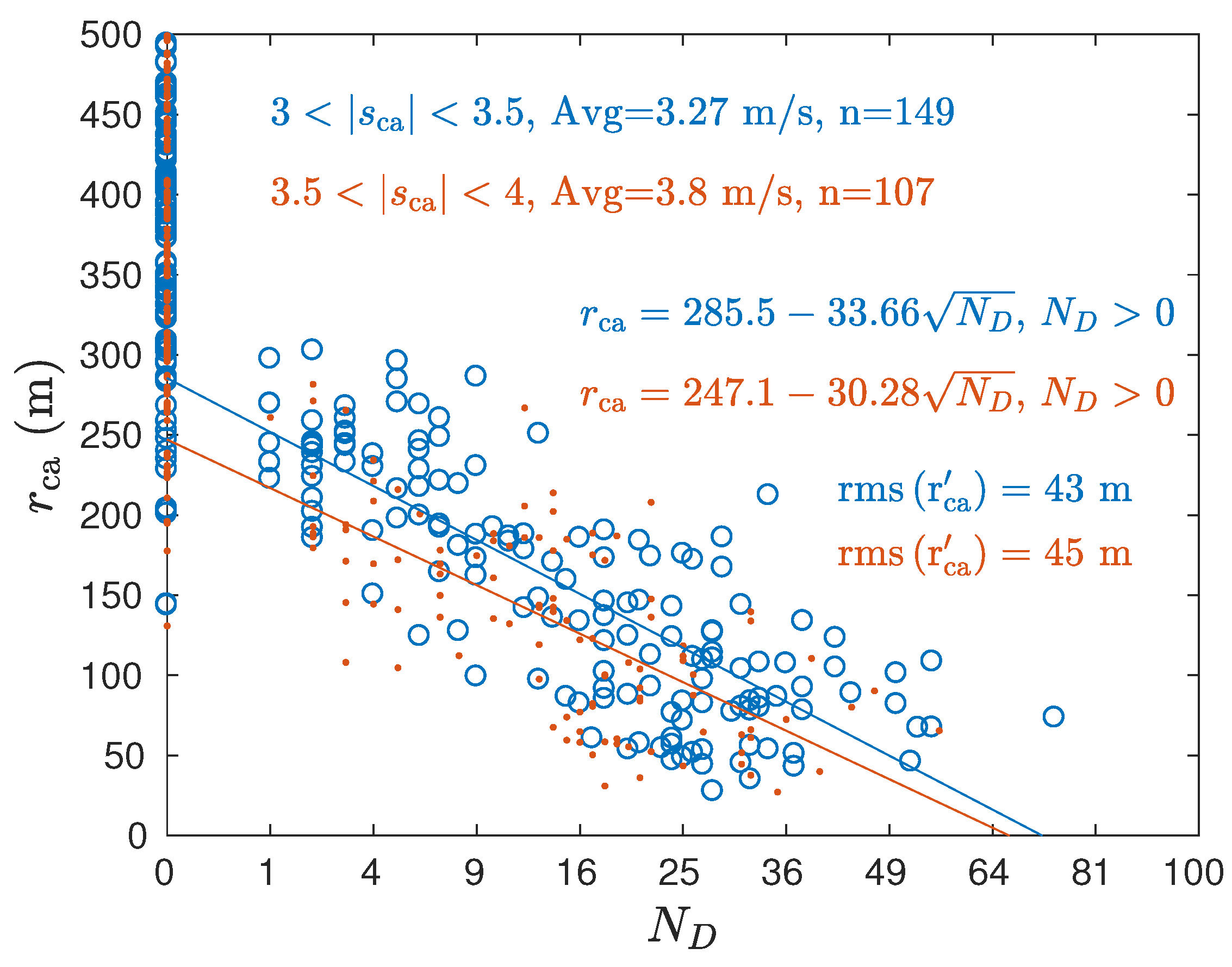1. Introduction
There has been, and continues to be, a substantial effort to develop marine renewable energy (MRE) in order to address the effects of climate change and ensure a transition from carbon-based energy sources that is both sustainable and environmentally benign [
1]. In Minas Passage, Bay of Fundy, tidal currents can exceed 5 ms
and raises the possibility that marine hydrokinetic (MHK) turbines [
2,
3] might be used to generate electricity from the kinetic energy of the tides, thereby, offseting Canadian carbon emissions [
4,
5]. An area has been designated and equipped for tidal energy demonstration (TED) adjacent to the northern shore of Minas Passage, Bay of Fundy, Canada (
Figure 1). Installation of MHK turbines is subject to assessing and mitigating potential harm to marine animals;
Canadian Environmental Assessment Act, Fisheries Act, and Species at Risk Act [
6]. There is particular concern for local populations of various fish species that are found in the region [
7,
8,
9]. For example, a local population of striped bass
(Morone saxatilis) that spawns in the Shubenacadie River [
10], Atlantic sturgeon
(Acipenser oxyrhinchus) from the Saint John River stock [
11], and inner Bay of Fundy Atlantic salmon
(Salmo salar) that were once abundant but are now supported by local hatchery stocking programs [
12].
Acoustic telemetry provides a means to tag individuals belonging to a specific population and measure how frequently they pass through the TED area. If an acoustic receiver is placed within the TED area and it detects an acoustically tagged fish then there is a distribution of positions about the receiver where the fish might be, and that distribution can be estimated if we know the detection efficiency of a signal from the acoustic tag. Detection efficiency
has been measured in the TED area and enables detections of tagged fish to be converted into an estimate of abundance [
13]. When current is fast, tagged fish move with the water to a first approximation [
14] so the flux of tagged fish can be estimated. Thinking of the receiver as a proxy for where a MHK turbine might later be deployed, this flux yields the probability that a tagged fish might pass through the area swept by MHK turbine blades. We call this an Eulerian formulation [
15] for the probability of fish-turbine encounter.
Probability of encounter is only an upper limit on probability of harm. A fish that encounters a MHK turbine might avoid dangerous interaction or may even be struck by a turbine blade but not be harmed [
16,
17] but presently there is little prospect of measuring avoidance behaviour and strike survivability at the TED area in Minas Passage [
18].
Detection efficiency
has been measured in the TED area as a function of range
r from tag to receiver and signed current speed
s (± on flood/ebb tides) [
13]. Those measurements were made using Innovasea high residency (HR) tags and Innovasea HR2 receivers that were moored near the seafloor and there were indications that signal paths were sometimes blocked by variable bathymetry. In Minas Passage MHK turbines have been deployed, and are expected to be deployed, well clear of the seafloor and many of the fish species of concern are known to also swim well clear of the seafloor at the TED area [
10,
11,
19]. There is, therefore, a pressing need to verify the extent to which the previously measured detection efficiency [
13] is applicable to the detection of tags that are located higher in the water column. Also, tagged fish move more like drifters than moored tags [
14] and whether a signal is detected during the time interval in which a tagged fish passes by a receiver may differ from that estimated from detection efficiency [
13]. There is a need for comparison with direct measurement.
To be more representative of a tagged fish, the following work deployed HR tags suspended beneath drifters to test whether they were detected by near seafloor receivers in a way that was consistent with previously measured detection efficiency [
13]. Two measurement strategies were used. First, short term drifts (STD) where the tagged drifter was repeatedly released upstream and collected downstream of HR2 receivers at the TED area (section 2.2). Second, long term drifts (LTD) where drifters were released on a quasi-stable trajectory [
14] and not recovered until many days later. The quasi-stable trajectory [
14] resulted in the tagged drifter frequently passing over HR2 receivers moored to the south of the TED area and sometimes over HR2 receivers at the TED area (section 2.3).
Conventionally, detection efficiency has been measured using acoustic tags that are fixed to one position and a receiver that is fixed to another position [
13,
20,
21]. Although seldom stated, such measurements give a strictly Eulerian formulation for detection efficiency. Such measurements of detection efficiency are related to the problem of detecting a tagged fish. The presently obtained measurements enable a demonstration of a Lagrangian formulation [
15] for directly obtaining the probability of detecting an individual tagged fish as it passes by.
2. Materials and Methods
The volcanic plateau of the TED area in Minas Passage (
Figure 1) is presently favoured for future installations of both gravity-based MHK turbines and also for MHK turbines mounted to a floating platform [
2]. The field program was designed to minimize the possibility of equipment, particularly drifters, becoming entangled with a non-operational OpenHydro turbine at the position marked by a circled cross in
Figure 1a.
2.1. Moorings
Twelve mooring sites were chosen so as to deploy an array of acoustic receivers on high ground along a line that was oriented approximately orthogonal to the flood tide (
Figure 1). Mooring sites 1-8 monitored tagged drifters that crossed a line to the south of the TED area. Sites 10-12 were on the volcanic plateau and site 9 was in deeper water off the edge of the plateau. Jointly, sites 9-12 are considered to monitor the TED area. Whereas the volcanic plateau is relatively flat, the area to its south is characterized by highly variable bathymetry
Figure 1b.
All moorings consisted of a 240 kg chain link that served as an anchor to which a SUBS-Model A2 (Open Seas Instrumentation Inc.) float was tethered by a 3 m riser chain. Each SUBS carried an acoustic release and a HR2 receiver within its streamlined hull and a Innovasea VR2W-69kHz receiver mounted symmetrically behind its tail fin. The HR2 receivers were set to transmit 143 dB HR signals every 25-35 s and record tilt and water temperature every 10 minutes. At moorings 9-12, a V9 tag was mounted to the top of the SUBS tail fin and it transmitted a 170 kHz HR signal with manufacturer-specified transmission interval 1.8-2.2 s. Actual transmission intervals for the V9 tags were 1.800-2.1750 s with an average of 1.9875 s. V9 tags at moorings 9 and 10 operated throughout the deployment period but the tags at moorings 11 and 12 failed on 16 July 2022 and 1 August 2022 respectively.
Moorings were deployed during 5-6 May 2022. The SUBS at mooring 3 re-surfaced immediately following deployment. The hull of the SUBS was deformed and scuffed and the attachment for its mooring assembly (anchor and riser chain) had sheared from the fibreglass strong-back that held the acoustic release. The most likely explanation was that the anchor of mooring 3 had fallen into a deep crevasse that was too narrow for the SUBS to follow.
An initial estimate of each mooring deployment position was obtained from the deployment vessel’s GPS at the time that the mooring was released overboard from the stern. This estimate of mooring position had uncertainty due to the vessel’s GPS being located 10.4 m forward of the stern and vessel heading being variable and uncertain when the mooring was released. Three Columbus V990 GPS loggers recorded position every second and were used to refine the deployment position. A Columbus GPS logger was placed each side of the stern deck and the third Columbus GPS logger was used to mark the time at which a mooring was released overboard.
Of the 11 moorings successfully deployed, 10 were recovered on 6 September 2022 with receivers in good working order. The acoustic release at mooring 5 did not respond to the deck unit and could not be `ranged’, suggesting that the SUBS had previously detached from its anchor weight and had drifted elsewhere. On 18 September 2022 the SUBS from mooring 5 washed ashore near Harbourville, Nova Scotia, and was promptly recovered with its chain riser still attached to the acoustic release. The VR2W receiver had broken off the SUBS and was lost, but the HR2 was still attached and its data were successfully downloaded. The last time the HR2 at mooring 5 detected HR signals from neighbouring moorings was 13-August-2022 00:55:41, so it must have become detached from its anchor weight at about that time.
HR2 clocks were set relative to UTC shortly before mooring deployment and shortly after mooring recovery when data were downloaded. Those clock sets enable linear clock skew to be corrected by Innovasea software as a part of the data download. Over the deployment period for the 11 HR2 receivers that were recovered, linear time offsets ranged from -172 s to 161 s with mean -80 s and root mean square 132 s. Providing a pair of HR2 receivers could detect each other’s HR transmissions, their separation range was calculated and their clocks were synchronized to each other [
13].
2.2. Short-term drifts (STD)
Short term drifts (STD) comprised many (n=62) brief drifts during spring flood tides in order to determine how well HR tags could be detected as they passed over the array of HR2 receivers deployed in the TED area. A pole-float was convenient for quick and easy handling during drifter deployment and recovery.
A Columbus V-990 GPS logger was fixed to the top of the pole float and logged GPS position every second. Beneath the sea surface, the pole-float drifter was configured with four V9 170 kHz HR tags placed at 3 m, 8 m, 16 m, and 26 m subsurface depths. The V9 tags transmitted a HR signal every 1.8-2.2 s. A HR2 receiver was suspended at 21 m depth with its hydrophone sensor pointing downwards and configured to record temperature and instrument tilt every 60 s. A V16 69 kHz PPM tag was attached at 27 m subsurface and transmitted every 10 s. A 4.7 kg lead weight was attached 28.5 m subsurface to vertically align equipment within the water column.
The STD were conducted using a 6 m rigid-hull inflatable boat (RHIB) that was fitted with a 110 hp outboard engine. Experiments were conducted during relatively calm weather and timed to coincide with large spring tides so tests could be conducted during elevated tidal current speeds. Although the pole-float drifter was not drogued, the fast tides and light winds ensured that drifter movement was a good approximation to that of the the top 28 m of the water column. Most measurements were made on and about peak flood tide because those were the conditions for which we had least confidence in the reliability of the previously measured detection efficiency [
13].
The operating procedure was to deploy the drifters about 800-1000 m upstream of the moored receivers and begin recovering them after they had drifted 600 m past the receivers. Deployment was swift and easy, so drifters were almost always safely set and the research vessel’s engine turned off before the drifter had approached within 500 m of the moorings. Recovery was laborious and time consuming which limited how many drift tracks could be achieved in a day. Onset of wind or fog shortened some working days. Drifts were conducted on 13 June (n=16), 15 June (n=15), 16 June (n=6) 17 July (n=16) and 18 July (n=9).
The HR2 suspended beneath the STD operated over short time periods and clock sets gave linear time offsets of -5.5 s over the June experiments and -3.9 s over the July experiments. When signals from the drifting HR2 were detected by moored HR2 receivers, it was possible to synchronize clocks between the moorings and drifter.
2.3. Long-term drifts (LTD)
The long-term drifters were designed so they could be tracked remotely using either a web browser or an application (app) on a smart phone or tablet. Drifters suspended HR tags and were usually deployed so that they would settle onto quasi-stable trajectories that passed over the moored HR2 receivers [
14]. When drifters went off track, they could be located using the app and recovered or redeployed. Field operations used the 6 m RHIB employed for the STD experiments.
Three long term drifters were constructed. Each drifter consisted of a surface float, a 1.8 m by 2.45 m window shade drogue centered at 6.3 m depth, and a long trailing line that held instruments and terminated at a 7 kg steel weight. The surface float was constructed from 38 mm ABS pipe and standard plumbing fittings with flotation fashioned from 50 mm boards of extruded polystyrene foam. Batteries and electronics were assembled on a length of ABS and slid into the ABS pipe.
The electronics package consisted of a Tractive® GPS LTE dog tracker, a Columbus V-990 GPS logger, and a buck converter that supplied 5V DC via USB connectors. The Tractive® enabled remote tracking but provided position measurements at irregular intervals, ranging from a few minutes to many hours depending upon the cellular network. The Columbus V-990 logged GPS positions every second but had to be physically recovered to download data. The buck converter could provide 5V-USB to instruments from a 8-24V D-cell stack.
The Columbus GPS logger prematurely stopped logging during some early LTD drifts because an inappropriate USB cable was used to connect with the buck converter. This problem was solved by using the USB cable that was sold with the Columbus GPS logger.
2.4. Tidal current and surface elevation
Using drifters that carry both acoustic tags and GPS loggers has the advantage of providing current information that coincides with detection of tags by moored receivers. Nevertheless, the detection efficiency which we aimed to test was formulated as a function of current speeds that were calculated by the FVCOM hydrodynamic model [
4,
13,
22]. Tidal currents and sea surface elevation have been simulated for the Bay of Fundy and the present work utilizes values saved at 10-minute intervals at each of the mooring positions. Modelled tidal elevation was used to obtain the vertical part of tag-receiver separation so that slant-range could be calculated.
4. Discussion
Using efficient MHK turbines [
24] to harvest tidal energy at locations with high power density [
4] is a state-of-the-art undertaking but less intensive use of tidal energy is not a new thing. Humans have exploited energy of the turning tide ever since they began to use fishing weirs and marine craft [
26]. Recently an intertidal fishing weir in Minas Basin was used to quantify fish species found in Minas Basin [
9]. The basic principle of a fishing weir is to collect fish that would otherwise pass by with the tide, and that is a conceptual starting point for quantifying an upper bound on the number of fish that might interact with an operating MHK turbine in Minas Passage.
To extract tidal energy, MHK turbines can be mounted to some stationary platform [
2]. If one were to replace the MHK turbine with a net that spans the same cross-current area
swept by the turbine blades then the fish caught could be considered to approximate the number of individuals (belonging to captured species) that might pass through the operating turbine. Such measurements of the flux of fish through
are in the Eulerian frame [
15]. Ecologists have similarly attempted to use active hydroacoustic devices to monitor backscatter from targets in a water volume similar to that which fluxes through
but it has not proven possible to enumerate individuals or identify species from the backscatter observed in Minas Passage [
18]. Optical cameras provide much higher resolution [
28] and visibility may be sufficient in Minas Passage for cameras to identify a subset of those fish that an active hydroacoustic device detected upstream as backscatter.
It would be most useful if the above Eulerian methods successfully measured the number of individuals (for some species) that might encounter a MHK turbine, but that would still leave outstanding issues. From a population point of view, what matters is not so much the number that encounter a MHK turbine, but rather the proportion of a local population that encounters a MHK turbine. That proportion is difficult to calculate from catch/backscatter numbers because the local population number is not known for any of the species captured by [
9]. Also, sometimes two fish belonging to the same species may belong to different populations [
11]. Such difficulties can be resolved by using acoustic tags [
10,
11] to track individuals belonging to a known population, which amounts to measuring in the Lagrangian frame [
15]. Tagging studies have been published for striped bass of Shubenacadie River origin [
10], Atlantic sturgeon that mostly originate from the Saint John River, New Brunswick [
11], and alewife of the Gaspereau River stock [
29]. Inner Bay of Fundy Atlantic salmon have also been acoustically tagged and released into tributaries of Minas Basin [
30]. Acoustically tagging fish subsampled from some population enables a Lagrangian estimate of the probability that individuals might encounter a MHK tidal turbine. Lagrangian methods provide population-specific information that augments the previously discussed Eulerian methods which attempt to count all fish that pass through
.
It was hoped that probabilities of fish-turbine encounter could be calculated from measurements of striped bass [
10] and Atlantic sturgeon [
11] which carried 69 kHz PPM tags. Such calculations require estimates of detection efficiency in order to transform detected signals into estimates of abundance or a probability distribution of distance from the detecting receiver [
13]. Detection range testing in Minas Passage [
23] showed poor detection efficiency for 69 kHz PPM tags when current speed was fast. Another study [
31] found that sturgeon carrying 69 kHz PPM tags were seldom detected in Minas Passage when current was fast. The present results confirm that fish carrying 69 kHz PPM tags are unlikely to be detected by the receiver array in fast currents and yet will be detected by many receivers in the array when current is slow. For estimating probability of encounter, being detected over too wide an area causes uncertainty and not being detected biases values low in fast currents for which the possibility of harmful fish-turbine encounters might be anticipated to be more likely.
Those shortcomings of PPM tags motivated the use of HR tags to track fish passing through the TED area in Minas Passage. Alewives carrying HR tags were detected at the TED area during a range of flood and ebb current conditions [
29] which supported further consideration of HR tags. Detection range measurements [
13] show that the HR signals are better detected than PPM signals in fast currents. A single PPM signal is extends over an interval
s whereas a HR signal takes only 6 ms so it is possible to transmit a great many more HR signals which gives more chances for a HR tag to be detected (
6). The present work quantifies how a higher transmission rate makes it more likely that a drifter carrying a HR tag (a proxy for a tagged fish) will be detected by fixed receivers (
Table 3).
When a PPM signal is reflected from the sea surface [
13] it can cause close proximity detection interference [
21] and prevent a nearby PPM tag from being detected. We observe that there are also geometric configurations of tag and receiver for which a HR signal overlaps with its reflection from the sea surface (
3) but that only happens for a narrow set of circumstances, mostly when the tag is very near the sea surface and the sea surface is calm (
Table 3). Under slightly different geometric circumstances, the reflected signal will not overlap with that taking a direct path and so the HR2 receiver has a second opportunity to detect the one HR transmission. Reflected signals are less likely to be observed, and less likely to cause interference, when the sea surface is rougher ([
13],
Table 5).
Another concern about both HR and PPM signal propagation was that previous detection range experiments [
13,
23] placed both receiver and acoustic tag close to the seafloor so that signals might sometimes be blocked by variable bathymetry. Those previous experiments could not unambiguously identify where signal paths were blocked. The present mooring layout (
Figure 1b) affords one obviously blocked path (mooring 9 to 10) plus a matching clear path (mooring 9 to 8) and results demonstrate that detection efficiency is profoundly diminished for the blocked signal path (
Figure 5). This justifies a decision to reject paths along which signal detection was poor in order to obtain an estimate for detection efficiency
that applies to tagged fish that swim well clear of the seafloor [
13].
Detection efficiency
is usually measured in the Eulerian frame with both acoustic tag and receiver being at fixed coordinates relative to the seafloor [
13,
20,
23]. On the other hand, a tagged fish is naturally described in Lagrangian frame [
15] as defined by its position at some initial time and subsequent trajectory due to movement by tidal current and swimming behaviour. To achieve a robust estimate for probability of fish-turbine encounter, we need to quantify that a fish carrying a HR tag will be detected as it passes over an array of HR2 receivers that monitor the TED area. Equation (
6) relates the Eulerian detection efficiency
[
13] to the number of times a HR signal is expected to be detected from a tagged fish (Lagrangian) as it passes a moored receiver. Given that
tended to overestimate the number of detection-positive intervals [
13], the presently reported experiments were deemed necessary to directly measure how many times a fixed receiver detects a drifting tag as it passes by. Equation (
6) was found to overestimate the number of passing trajectories for which there was at least one detected signal and that overestimation can be attributed to autocorrelation of variability about the general functional form of
. Nevertheless, most of the HR tags that drifters carried through the HR2 receiver array were detected, even during spring flood-tides when current speeds were near their greatest extent in the TED area. Sometimes a passing tag was detected only a small number of times, so there was little margin for error. Indeed, the HR tags transmitted every 1.8 to 2.2 s and if they had transmitted at longer intervals then more tags would have passed by without being detected. A tagged fish that actively swims in the same sense as the tidal current may be somewhat less likely to be detected than a tagged fish drifting with the current [
14].
The issue of tagged fish passing through a receiver array without being detected is also central to studies that use a sequence of receiver arrays to measure migration and mortality/loss of tagged fish [
29,
32,
33]. When fish are migrating, it is often possible to utilize detections of the tagged fish to roughly estimate detection efficiencies of most receiver arrays along the migration route, except for the last array [
29,
33]. It is very desirable, therefore, that the last array be designed so that it will detected all migrating fish as they pass by. The above work shows that detection range measurements are useful for obtaining a first estimate of the probability that the migrating fish will be detected by an array but that estimate will be biased a little high.
A total of four HR2 receivers were used to monitor the TED area during this experiment. Although this was sufficient to detect the majority of HR tags passing by on drifters, the number of signals detected during a passing event was often small when tidal currents were greatest. It would be better to have had more HR2 receivers monitoring the TED area in order to (1) provide some redundancy in case of instrument failure, (2) better ensure that every tagged fish would be detected as it passed by, and (3) increase the possibility of localizing the position of a passing tag when several receivers detect the same HR signal. Localization does not have to be perfect, but it would be very helpful to know if tagged fish passed directly over the TED area or a little to the north or south.
Additionally, it would be advantageous to have a mooring system that enables HR2 receivers to be held sufficiently off the seafloor so as to prevent signals from one HR2 from being blocked before they reached a neighbouring HR2. If this could be achieved then HR detection efficiency could be accurately monitored as a function of time throughout the period when tagged fish are also being monitored. Rather than only relying on a fitted function for detection efficiency , it would be advantageous to also have a direct measurement of detection efficiency for the minute before and after a tagged fish is actually detected.
In conclusion, we were fortunate not to have had HR2 failures in the TED area and it is now possible to demonstrate how
can be used to calculate probability of fish-turbine encounter when the array detects tagged fish as they pass through the TED area [
25].
Figure 1.
Mooring layout in Minas Passage. (a) Plan view shows moorings 1 through 12 and the TED area (gray box). (b) Depth profile along the mooring line. Inset shows location of the moorings within Minas Passage, Bay of Fundy.
Figure 1.
Mooring layout in Minas Passage. (a) Plan view shows moorings 1 through 12 and the TED area (gray box). (b) Depth profile along the mooring line. Inset shows location of the moorings within Minas Passage, Bay of Fundy.
Figure 2.
STD tracks. Positions of moorings 9-12 are marked with blue dots. Black lines show flood tracks. Ebb tracks are magenta. Tracks were measured on: (a) 13, 15 and 16 June 2022 (n=37). (b) 17 and 18 July 2022 (n=25).
Figure 2.
STD tracks. Positions of moorings 9-12 are marked with blue dots. Black lines show flood tracks. Ebb tracks are magenta. Tracks were measured on: (a) 13, 15 and 16 June 2022 (n=37). (b) 17 and 18 July 2022 (n=25).
Figure 3.
Nonlinear offset to synchronize receivers at stations 9 through 12 to the receiver at station 9.
Figure 3.
Nonlinear offset to synchronize receivers at stations 9 through 12 to the receiver at station 9.
Figure 4.
Signals detected as a function of distance and range along STD tracks. (a) Many signals are detected at moderately high current speed. (b) Fewer signals are detected at very high current speed.
Figure 4.
Signals detected as a function of distance and range along STD tracks. (a) Many signals are detected at moderately high current speed. (b) Fewer signals are detected at very high current speed.
Figure 5.
Average detection efficiencies are plotted as functions of with black circles and lines indicating . Signals from the HR tag at mooring 9 are detected by: (a) the HR2 at mooring 8, (b) the HR2 at mooring 10. For corresponding ranges, the red lines shows detection efficiencies measured in 2022. The distribution of detection efficiencies calculated from 2-minute intervals is shown using a logarithmic color scale. The distribution was normalized to a maximum value of 100 per - bin.
Figure 5.
Average detection efficiencies are plotted as functions of with black circles and lines indicating . Signals from the HR tag at mooring 9 are detected by: (a) the HR2 at mooring 8, (b) the HR2 at mooring 10. For corresponding ranges, the red lines shows detection efficiencies measured in 2022. The distribution of detection efficiencies calculated from 2-minute intervals is shown using a logarithmic color scale. The distribution was normalized to a maximum value of 100 per - bin.
Figure 6.
The expected number of detected signals declines with increasing slant range of closest approach . Only the 44 STD tracks with ms are included.
Figure 6.
The expected number of detected signals declines with increasing slant range of closest approach . Only the 44 STD tracks with ms are included.
Figure 7.
Number of detected signals for STD passing events plotted as a function of the number expected.
Figure 7.
Number of detected signals for STD passing events plotted as a function of the number expected.
Figure 8.
Two LTD tracks. A quasi-steady track (black) frequently passes near the southern end of the line of moored receivers (blue). A highly variable track (orange) sometimes passes through the northern end of the receiver line.
Figure 8.
Two LTD tracks. A quasi-steady track (black) frequently passes near the southern end of the line of moored receivers (blue). A highly variable track (orange) sometimes passes through the northern end of the receiver line.
Figure 9.
Dots indicate where LTD tracks crossed the mooring line, with flood crossings displaced to the left and ebb crossings displaced to the right. Blue dots indicate passing events that were detected by the array of HR2 receivers and orange dots indicate passing events that were not detected.
Figure 9.
Dots indicate where LTD tracks crossed the mooring line, with flood crossings displaced to the left and ebb crossings displaced to the right. Blue dots indicate passing events that were detected by the array of HR2 receivers and orange dots indicate passing events that were not detected.
Figure 10.
For each crossing that is south of mooring 6, the signed speed of the drifter is compared with the value obtained from the FVCOM model A best-fit linear regression is plotted (purple).
Figure 10.
For each crossing that is south of mooring 6, the signed speed of the drifter is compared with the value obtained from the FVCOM model A best-fit linear regression is plotted (purple).
Figure 11.
Relating the number of HR signals detected during a LTD passing event to the range at closest approach for measurements grouped according to the speed at closest approach . Each HR tag transmitted every s.
Figure 11.
Relating the number of HR signals detected during a LTD passing event to the range at closest approach for measurements grouped according to the speed at closest approach . Each HR tag transmitted every s.
Figure 12.
Percentage of tag passing events that are detected by a moored HR2 receiver as a function of speed and range at closest approach. Here we consider LTD of the two deepest HR tags (19 m and 28 m). Each tag transmitted every s.
Figure 12.
Percentage of tag passing events that are detected by a moored HR2 receiver as a function of speed and range at closest approach. Here we consider LTD of the two deepest HR tags (19 m and 28 m). Each tag transmitted every s.
Table 1.
Separations between moorings.
Table 1.
Separations between moorings.
| Mooring Pair |
Separation (m) |
Dates |
Depths (m) |
| 1–2 |
166 |
07-May 06-Sep-2022 |
66.3, 69.2 |
| 4–5 |
209.5 |
07-May 14-May-2022 |
59.3, 59.9 |
| 4–5 |
209.4 |
14-May 13-Aug-2022 |
60.0, 59.9 |
| 5–6 |
106 |
07-May 13-Aug-2022 |
— , — |
| 6–7 |
206 |
07-May 06-Sep-2022 |
61.1, 52.8 |
| 7–8 |
123 |
07-May 14-Jun-2022 |
— , 49.7 |
| 7–8 |
132 |
18-Jun 17-Jul-2022 |
— , 49.6 |
| 7–8 |
135 |
19-Jul 12-Aug-2022 |
— , 50.4 |
| 7–8 |
137 |
13-Aug 06-Sep-2022 |
— , 50.7 |
| 8–9 |
190 |
07-May 12-May-2022 |
50.0, — |
| 8–9 |
193 |
14-May 14-Jun-2022 |
50.0, — |
| 8–9 |
200 |
19-Jun 17-Jul-2022 |
49.6, — |
| 8–9 |
206 |
19-Jul 06-Sep-2022 |
50.5, — |
| 9–10 |
182 |
07-May 06-Sep-2022 |
48.4, 34.8 |
| 10–11 |
133 |
07-May 15-May-2022 |
— , 34.1 |
| 10–11 |
152 |
19-May 14-Jul-2022 |
— , 34.9 |
| 10–11 |
174 |
17-Jul 06-Sep-2022 |
— , 35.7 |
| 11–12 |
211 |
07-May 15-May-2022 |
34.1, 34.9 |
| 11–12 |
232 |
21-May 14-Jul-2022 |
34.9, 34.8 |
| 11–12 |
230 |
17-Jul 06-Sep-2022 |
35.7, 34.9 |
Table 2.
Time corrections to add to the HR2 at mooring 9 in order for it to match the HR2 receiver suspended below the pole-float drifter.
Table 2.
Time corrections to add to the HR2 at mooring 9 in order for it to match the HR2 receiver suspended below the pole-float drifter.
| Drift number |
Date |
Time correction (s) |
| 11 |
13 Jun 2022 |
16.75 |
| 31 |
15 Jun 2022 |
16.45 |
| 54 |
18 Jul 2022 |
15.5 |
| 55 |
18 Jul |
15.5 |
Table 3.
Out of the 45 fast ( ms) STD passing events, we tabulate the number of passing events () for which a tag at a given depth was detected by the HR2 array.
Table 3.
Out of the 45 fast ( ms) STD passing events, we tabulate the number of passing events () for which a tag at a given depth was detected by the HR2 array.
|
(s) |
3 m tag |
8 m tag |
16 m tag |
26 m tag |
| 2 |
39 |
38 |
42 |
44 |
| 4 |
36 |
37 |
40 |
42 |
| 8 |
31 |
34 |
34 |
39 |
| 16 |
22 |
25 |
26 |
34 |
| 32 |
14 |
17 |
17 |
21 |
| 64 |
7 |
10 |
10 |
13 |
Table 4.
Comparison of number of signals detected by an array with number expected at each tag depth. Measurements from 44 fast flood drifts at the TED area.
Table 4.
Comparison of number of signals detected by an array with number expected at each tag depth. Measurements from 44 fast flood drifts at the TED area.
| |
2.25 m tag |
9 m tag |
19 m tag |
28 m tag |
|
127 |
185 |
214 |
270 |
|
295 |
308 |
325 |
344 |
|
26 |
28 |
28 |
26 |
|
33 |
33 |
33 |
33 |
|
32 |
32 |
33 |
33 |
|
31 |
32 |
32 |
32 |
Table 5.
Out of 45 fast flood-tide ( ms) LTD passing events, we tabulated the number of passing events for which tags at different depths were detected by the HR2 array. Dependence on increasing transmission interval was calculated.
Table 5.
Out of 45 fast flood-tide ( ms) LTD passing events, we tabulated the number of passing events for which tags at different depths were detected by the HR2 array. Dependence on increasing transmission interval was calculated.
|
(s) |
2.25 m tag |
9 m tag |
19 m tag |
28 m tag |
| 2 |
41 |
42 |
40 |
42 |
| 4 |
41 |
42 |
40 |
42 |
| 8 |
40 |
41 |
39 |
40 |
| 16 |
35 |
39 |
37 |
37 |
| 32 |
28 |
34 |
34 |
31 |
| 64 |
18 |
26 |
27 |
21 |
Table 6.
Out of 36 slow flood-tide ( ms) LTD passing events, we tabulated the number of passing events for which tag at different depths were detected by the HR2 array. Dependence on increasing transmission interval was calculated.
Table 6.
Out of 36 slow flood-tide ( ms) LTD passing events, we tabulated the number of passing events for which tag at different depths were detected by the HR2 array. Dependence on increasing transmission interval was calculated.
|
(s) |
2.25 m tag |
9 m tag |
19 m tag |
28 m tag |
| 2 |
35 |
35 |
35 |
35 |
| 4 |
35 |
35 |
35 |
35 |
| 8 |
34 |
34 |
35 |
34 |
| 16 |
33 |
33 |
34 |
34 |
| 32 |
32 |
32 |
33 |
33 |
| 64 |
28 |
31 |
31 |
31 |
Table 7.
Out of 13 fast ebb-tide ( ms) LTD passing events, we tabulated the number of passing events for which tag at different depths were detected by the HR2 array. Dependence on increasing transmission interval was calculated.
Table 7.
Out of 13 fast ebb-tide ( ms) LTD passing events, we tabulated the number of passing events for which tag at different depths were detected by the HR2 array. Dependence on increasing transmission interval was calculated.
|
(s) |
2.25 m tag |
9 m tag |
19 m tag |
28 m tag |
| 2 |
9 |
11 |
12 |
13 |
| 4 |
9 |
11 |
12 |
13 |
| 8 |
9 |
10 |
12 |
12 |
| 16 |
8 |
10 |
11 |
11 |
| 32 |
8 |
9 |
10 |
9 |
| 64 |
5 |
7 |
7 |
7 |
Table 8.
Out of 44 slow ebb-tide ( ms) LTD passing events, we tabulated the number of passing events for which tag at different depths were detected by the HR2 array. Dependence on increasing transmission interval was calculated.
Table 8.
Out of 44 slow ebb-tide ( ms) LTD passing events, we tabulated the number of passing events for which tag at different depths were detected by the HR2 array. Dependence on increasing transmission interval was calculated.
|
(s) |
2.25 m tag |
9 m tag |
19 m tag |
28 m tag |
| 2 |
38 |
39 |
44 |
39 |
| 4 |
38 |
39 |
43 |
39 |
| 8 |
37 |
38 |
40 |
37 |
| 16 |
34 |
36 |
38 |
36 |
| 32 |
30 |
33 |
35 |
35 |
| 64 |
25 |
30 |
31 |
30 |
Table 9.
Number of LTD tracks for which the bottom HR and 69 kHz PPM tag were detected. Tracks are categorized according to whether current is fast or slow on the ebb or flood tide.
Table 9.
Number of LTD tracks for which the bottom HR and 69 kHz PPM tag were detected. Tracks are categorized according to whether current is fast or slow on the ebb or flood tide.
| # tracks |
HR tag |
PPM tag |
Current (ms) |
Mean current (ms) |
| 28 |
27 |
28 |
|
2.84 |
| 35 |
25 |
29 |
|
-2.8 |
| 35 |
34 |
19 |
|
4.17 |
| 11 |
11 |
1 |
|
-3.8 |
